Have you come across a bug that looks remarkably like a ladybug but is brown in color? If so, you’re not alone. In this article, I will help you identify this fascinating insect and understand its significance.
- The bug that resembles a ladybug but is brown is most likely the Asian lady beetle or Japanese ladybug (Harmonia axyridis).
- Asian lady beetles are orange-brown in color and can be a nuisance, especially when they gather in large numbers around houses.
- These beetles are beneficial insects as they eat aphids, but they can become a problem when they enter homes.
- Kudzu bugs are another brown bug often mistaken for a ladybug. They are dark brown or olive in appearance and feed on kudzu, soybeans, and ornamental plants.
- Various types of brown ladybugs exist, including the larch ladybug, Asian lady beetle, and painted ladybug, with different coloration and patterns.
- Brown ladybugs have evolved their brown coloration as a defense mechanism to blend in with their surroundings and avoid predators.
The Asian Lady Beetle: The Most Common Brown Ladybug Lookalike
The Asian lady beetle, also known as Harmonia axyridis, is often mistaken for a brown ladybug due to its similar appearance. Let’s dive into the distinguishing characteristics and behavior of this intriguing insect.
The Asian lady beetle is orange-brown in color and can be a nuisance, especially in the fall and winter when they gather in large numbers around houses. These beneficial insects are aphid predators, helping to control aphid populations in gardens and agricultural fields. However, they can become a problem when they enter homes, creating a nuisance for homeowners.
To remove Asian lady beetles from your home, you can use a vacuum cleaner to suck them up. Additionally, outdoor sprays can be used to discourage them from gathering on the side of the house. It’s important to remember that these beetles are beneficial insects, so if possible, it’s best to relocate them rather than harm them.
| Asian Lady Beetle Facts | |
|---|---|
| Scientific Name: | Harmonia axyridis |
| Color: | Orange-brown |
| Habitat: | Gardens, agricultural fields, and homes |
| Beneficial Role: | Aphid predator |
| Nuisance: | Potential house infestation |
Remember, it’s important to distinguish between the Asian lady beetle and true ladybugs. Although they may look similar, their behavior and impact can be quite different. Understanding the characteristics and habits of the Asian lady beetle can help you effectively manage any nuisance issues that may arise.
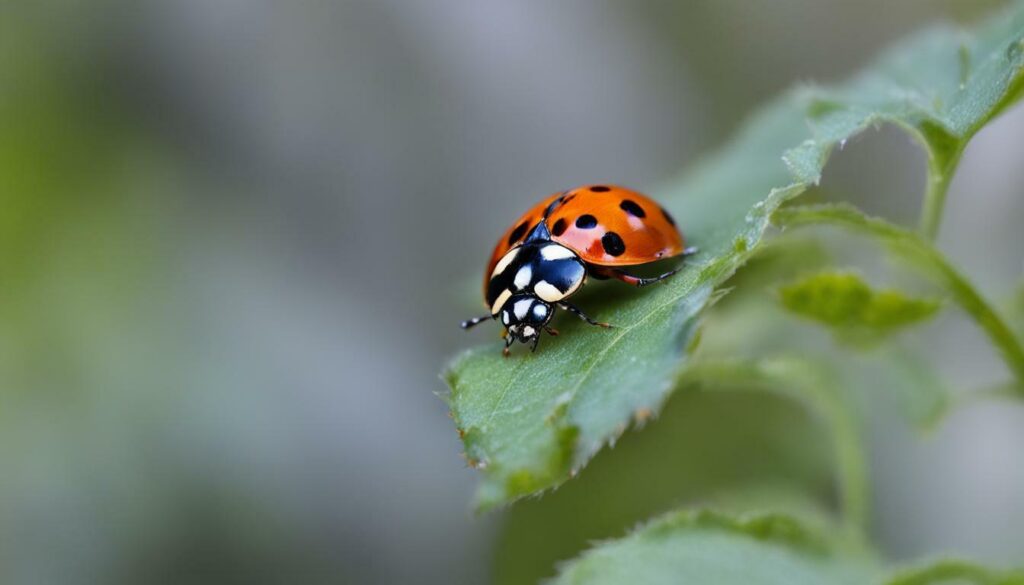
“The Asian lady beetle, also known as Harmonia axyridis, is an intriguing insect with a striking orange-brown coloration. While it may resemble a brown ladybug, it exhibits unique characteristics and behaviors that set it apart.”
The Kudzu Bug: Another Brown Bug with Ladybug Resemblance
Another brown bug that bears a resemblance to ladybugs is the kudzu bug. Let’s take a closer look at this insect’s features and its impact on plants.
The kudzu bug, scientifically known as Megacopta cribraria, is approximately a quarter of an inch long and can be found in various shades of dark brown or olive. These bugs are originally from Asia, but they have made their way to the United States, specifically the southeastern region. They are named after the kudzu vine, as they primarily feed on this invasive plant species. However, they can also be found on soybeans and ornamental plants.
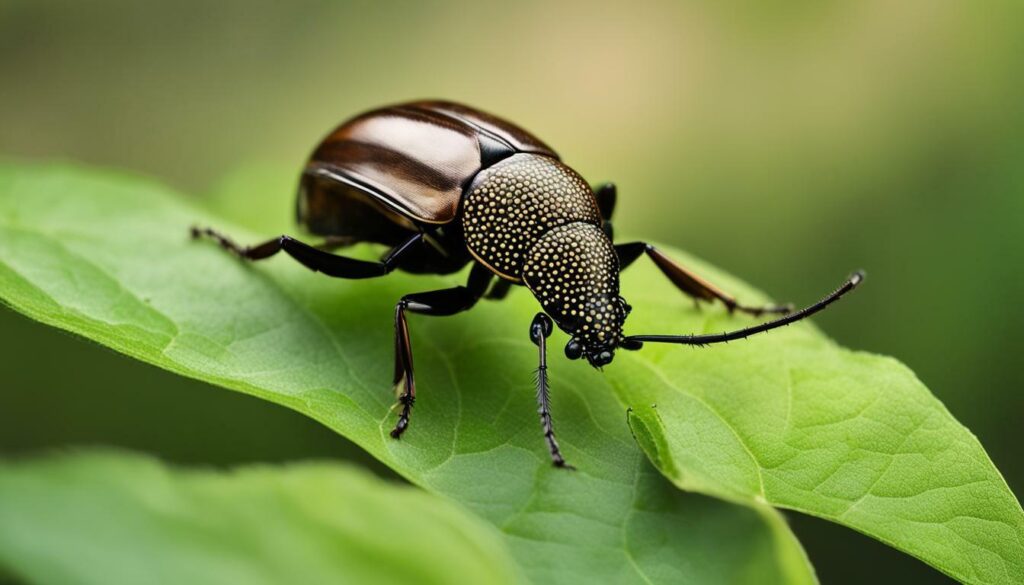
One notable characteristic of the kudzu bug is their ability to stain surfaces if crushed. When threatened or squashed, they release a yellowish fluid that can leave marks on walls, clothing, or any other surface they come into contact with. This staining behavior is one way they defend themselves against predators.
Although the kudzu bug is not known to cause significant damage to crops, their large populations can be considered a nuisance. Their rapid reproduction and feeding habits can lead to localized infestations, especially in areas where kudzu is prevalent. To manage kudzu bug populations, it is important to monitor plants for signs of infestation and take appropriate pest management actions when necessary.
| Kudzu Bug Characteristics | Kudzu Bug Impact |
|---|---|
| Size: Approximately a quarter of an inch | Staining: Can stain surfaces if crushed |
| Color: Dark brown or olive | Feeding Habits: Primarily feed on kudzu, soybeans, and ornamental plants |
| Habitat: Southeastern region of the United States | Impact: Can become a nuisance in areas with high kudzu populations |
Conclusion
The kudzu bug is a brown insect that often gets mistaken for a ladybug due to its similar appearance. While ladybugs are beneficial insects, the kudzu bug can be considered a nuisance, particularly in areas where kudzu is prevalent. Their feeding habits and staining behavior are noteworthy aspects of these bugs. Understanding their characteristics and impact on plants can help homeowners and farmers effectively manage and control kudzu bug populations.
Different Types of Brown Ladybugs
Ladybugs come in various shades of brown, and in this section, we will explore different species, such as the larch ladybug and the painted ladybug, that exhibit this coloration. These brown ladybugs belong to the beetle family Coccinellidae and have evolved their brown color as a defense mechanism to blend in with their surroundings and avoid predators. Let’s take a closer look at these unique species:
Larch Ladybug
The larch ladybug, also known as Aphidecta obliterata, is a type of brown ladybug commonly found in coniferous forests. It has a dark brown or reddish-brown coloration with small black spots on its elytra, or wing covers. The larch ladybug feeds primarily on aphids and scale insects, making it a beneficial insect for gardeners and farmers.
Painted Ladybug
The painted ladybug, scientifically known as Harmonia picta, is another brown ladybug species that can be found in various habitats, including gardens, fields, and forests. It usually has a brownish color with unique patterns of black markings on its elytra. Painted ladybugs are also natural predators of aphids and other soft-bodied pests, helping to keep their populations under control.
These brown ladybug species, along with many others, play important roles in our ecosystems by acting as natural pest control agents. Their ability to consume large numbers of aphids and other soft-bodied pests makes them valuable allies for farmers and gardeners. By understanding and appreciating the diverse species of brown ladybugs, we can better understand and protect the delicate balance of nature.
| Species | Coloration | Markings | Main Diet |
|---|---|---|---|
| Larch Ladybug | Dark brown or reddish-brown | Small black spots | Aphids, scale insects |
| Painted Ladybug | Brownish | Black markings | Aphids, soft-bodied pests |
Remember, it’s important to appreciate the beauty and diversity of these brown ladybugs and the important ecological role they play. Let’s continue our exploration of brown ladybugs in the next section as we delve into their physical characteristics.
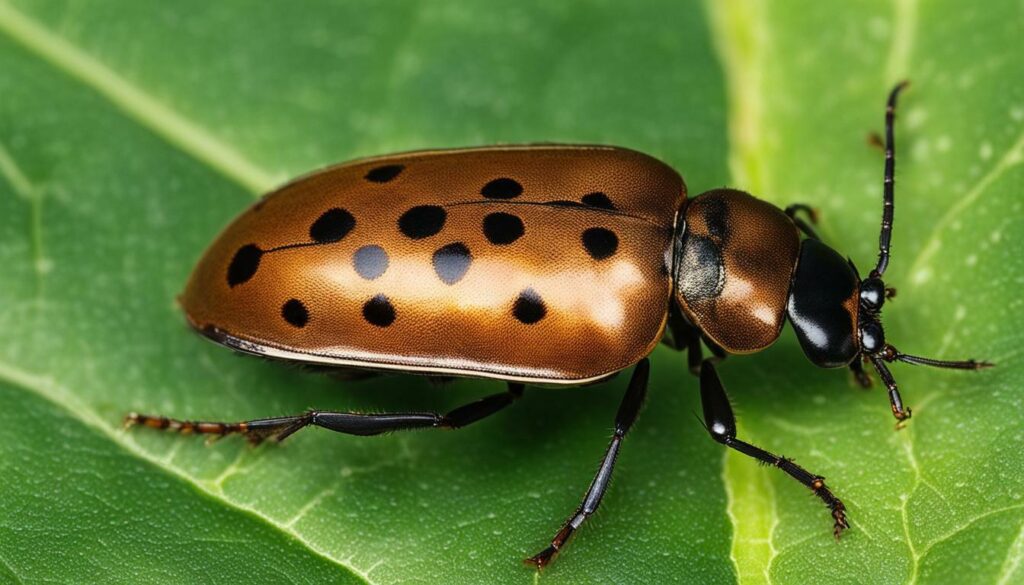
Brown ladybugs possess unique physical traits that set them apart from their more commonly known red counterparts. Let’s explore their distinct characteristics, such as their color patterns and wing covers.
One notable feature of brown ladybugs is their elytron, which is the hard outer wing cover. These wing covers can vary in color, ranging from dark yellow to brownish hues. Some species may also feature black spots or mottled patterns on their elytron, adding to their distinctive appearance. The elongate shape of their bodies further distinguishes them from other ladybug species.
While brown ladybugs may exhibit different colorations and patterns, their undersides generally remain consistent with their elytron. The undersides of these ladybugs often mirror the color and markings seen on their wing covers. This consistency in coloration serves as a protective adaptation, allowing them to blend into their surroundings and avoid potential predators.
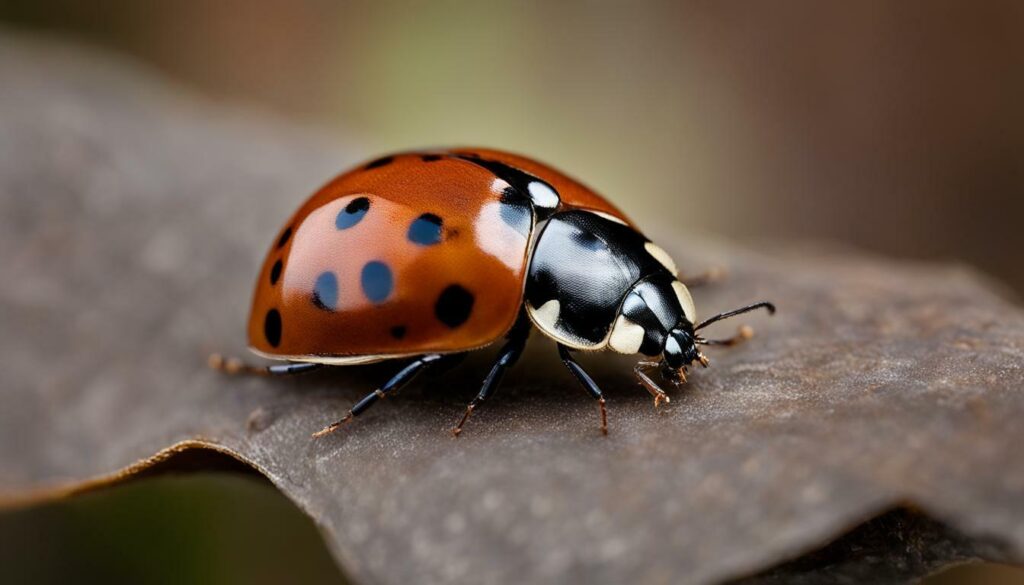
| Ladybug Species | Color Pattern | Distinct Features |
|---|---|---|
| Larch Ladybug | Dark yellow with black spots | Mottle appearance |
| Asian Lady Beetle | Orange-brown with black spots | Distinctive “M” or “W” marking on the pronotum |
| Painted Ladybug | Various shades of brown | Elaborate patterns and color variations |
Did you know? Brown ladybugs have evolved their coloration as a defense mechanism to blend in with their surroundings and avoid predators. Their ability to camouflage provides them with a survival advantage.
These unique physical characteristics make brown ladybugs easily distinguishable from other ladybug species. Their color patterns, wing covers, and undersides all contribute to their individuality. By understanding these distinct features, we can better appreciate the diversity that exists within the world of ladybugs.
Behavior and Habitat of Brown Ladybugs
Understanding the behavior and habitat of brown ladybugs is key to managing their presence. In this section, we will explore their seasonal habits and preferred nesting sites. Brown ladybugs, including the Asian lady beetle and other species, have unique behaviors and preferences that influence their interactions with humans and their environment.
During colder months, brown ladybugs, like many other insects, seek shelter to overwinter. They often find their way into homes through cracks around windows, doors, and siding. Once inside, they may nest in hidden areas, such as attics and wall voids, in search of warmth and protection. While they do not cause damage to structures, their presence indoors can become a nuisance.
In the springtime, brown ladybugs emerge from their winter hideouts and become more active. They display a strong affinity for light, often clustering near windows and light fixtures. This behavior can be attributed to their instinct to seek out the sun, which plays a crucial role in their reproductive cycle. As the weather warms up, brown ladybugs feed on aphids and other soft-bodied pests, contributing to natural pest control in gardens and agricultural fields.

To effectively manage brown ladybug populations, it is essential to identify potential entry points and nesting areas. Regularly inspecting and sealing cracks and gaps around the house can help prevent their indoor infestation. If brown ladybugs are already present, they can be safely removed using a vacuum cleaner. Outdoor sprays can also be applied to discourage them from gathering on the sides of the house.
| Behavior of Brown Ladybugs | Habitat of Brown Ladybugs |
|---|---|
|
|
While brown ladybugs can be an annoyance when they invade homes, it is important to appreciate their ecological role as beneficial insects. Their appetite for aphids helps to naturally control pest populations, reducing the need for chemical interventions. By understanding their behavior and habitat preferences, we can coexist with these unique insects while minimizing any potential inconvenience they may cause.
Benefits and Drawbacks of Brown Ladybugs
Brown ladybugs bring both advantages and disadvantages to our surroundings. In this section, we will evaluate their positive impact on controlling aphids and address the challenges they can present in large numbers.
One of the key benefits of brown ladybugs is their role as beneficial insects in aphid control. These ladybugs have a voracious appetite for aphids, which are soft-bodied pests that can cause significant damage to plants. By feeding on aphids, brown ladybugs help regulate their populations and protect crops and gardens from infestation. This natural form of pest control reduces the need for chemical insecticides, making brown ladybugs environmentally friendly allies in maintaining a healthy ecosystem.
However, brown ladybugs can become a nuisance when they gather in large numbers. They have a tendency to seek shelter indoors during the fall and winter months, which can lead to indoor infestations. While they do not cause any structural damage to homes, their presence can be bothersome, especially when they accidentally release a foul-smelling defensive chemical. Additionally, if crushed, brown ladybugs can leave stains on surfaces, which can be difficult to remove.
To address the challenges posed by brown ladybug infestations, it is important to take preventive measures. Seal cracks around windows, doors, and other entry points to minimize their access to indoor spaces. Regularly vacuuming them up using a vacuum cleaner can help remove them from inside your home. Outdoor sprays can also be used to discourage brown ladybugs from gathering on the sides of houses.
Table: Benefits and Drawbacks of Brown Ladybugs
| Benefits | Drawbacks |
|---|---|
| Effective in controlling aphids | Tendency to seek shelter indoors |
| Reduces the need for chemical insecticides | Possible release of foul-smelling chemicals |
| Eco-friendly form of pest control | Potential for staining surfaces |
Brown ladybugs, with their ability to control aphids and act as beneficial insects, play an important role in maintaining the balance of our ecosystems. While their tendency to gather in large numbers and seek shelter indoors can be a nuisance, taking preventive measures can help manage their presence. By understanding the benefits and drawbacks of brown ladybugs, we can appreciate their unique contribution to our surroundings and find ways to coexist harmoniously.
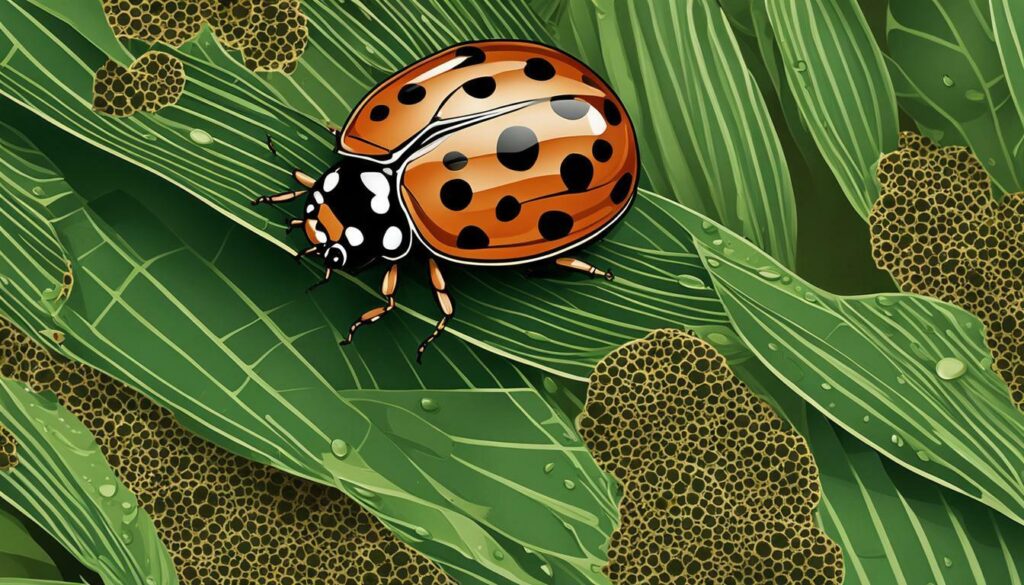
Although brown ladybugs can be beneficial in certain contexts, their presence in large numbers around homes can create problems for humans. In this section, we will discuss strategies for dealing with these household pests.
When it comes to addressing brown ladybug infestations, prevention is key. It is important to seal any cracks or entry points around your home to prevent these bugs from entering. Pay close attention to areas such as windows, doors, and siding, as these are common entry points for ladybugs seeking shelter.
If you do find yourself dealing with a brown ladybug infestation indoors, there are several methods you can use for removal. One effective approach is to use a vacuum cleaner to capture the ladybugs without squishing them, as squishing them may result in stains or foul odors. Alternatively, you can use outdoor sprays to deter ladybugs from gathering on the sides of your house and entering your home.
Best Practices for Dealing with Brown Ladybugs
Here are some best practices to consider:
- Seal cracks and entry points to prevent ladybugs from entering your home.
- Use a vacuum cleaner to remove ladybugs indoors, avoiding stains and odors.
- Consider using outdoor sprays to discourage ladybugs from gathering on the exterior of your house.
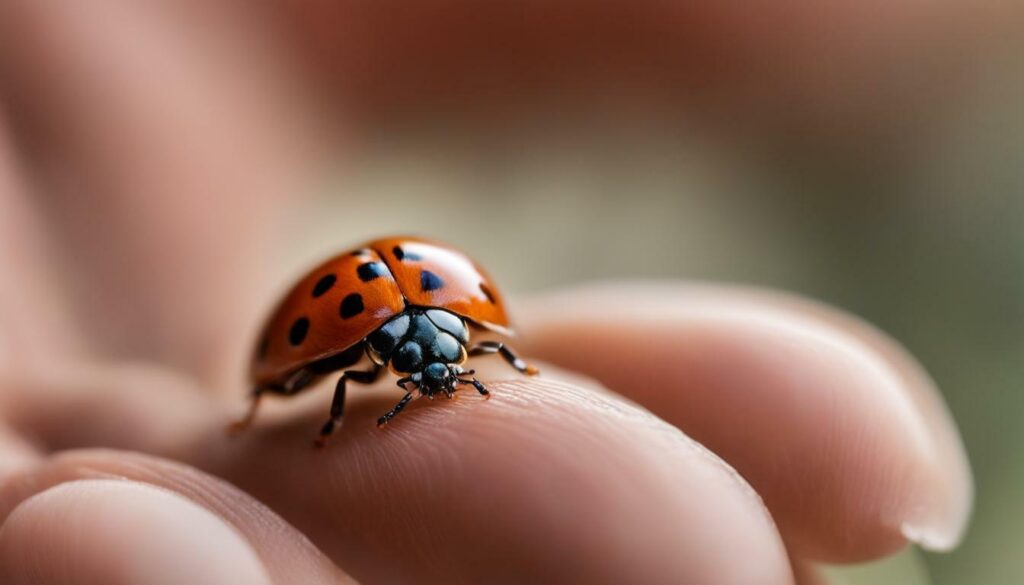
| Type | Color | Features |
|---|---|---|
| Larch Ladybug | Brown with black spots | Elongate body shape |
| Asian Lady Beetle | Orange-brown | May have black spots |
| Painted Ladybug | Brown with reddish-brown markings | Diverse coloration and patterns |
“Brown ladybugs can be beneficial in controlling aphid populations, but their large numbers can become a nuisance for homeowners.”
Remember, it’s important to appreciate the ecological role of brown ladybugs while finding a balance that ensures their presence doesn’t create discomfort or damage in your living space. By following these strategies, you can effectively manage brown ladybug infestations and reduce their impact on your home.
Identifying Brown Ladybug Larvae
Brown ladybug larvae may appear different from their adult counterparts, leading to confusion with other soft-bodied pests. In this section, we will help you recognize and distinguish these larvae from other insects. Ladybug larvae are often carrot-shaped and can range in color from bright orange to reddish-brown. They have elongated bodies with soft exteriors, making them easy targets for predators.
One distinguishing feature of brown ladybug larvae is their voracious appetite for pests such as aphids and scale insects. These larvae are natural predators and play an essential role in controlling pest populations. It’s important to note that these larvae may look quite different from their adult counterparts, so don’t be alarmed if you come across bright orange, carrot-shaped larvae in your garden or home.
To help you identify brown ladybug larvae, here are some key characteristics to look out for:
- Bright orange or reddish-brown color
- Carrot-shaped body
- Soft exoskeleton
- Predatory behavior towards pests
Distinguishing brown ladybug larvae from other soft-bodied pests can be challenging, but understanding their unique features will help you appreciate their role in natural pest control. Remember to handle these larvae with care as they are beneficial insects and contribute to maintaining a healthy ecosystem.
| Larvae Characteristics | Appearance |
|---|---|
| Color | Bright orange or reddish-brown |
| Body Shape | Carrot-shaped |
| Exterior | Soft |
| Feeding Behavior | Predatory towards pests |
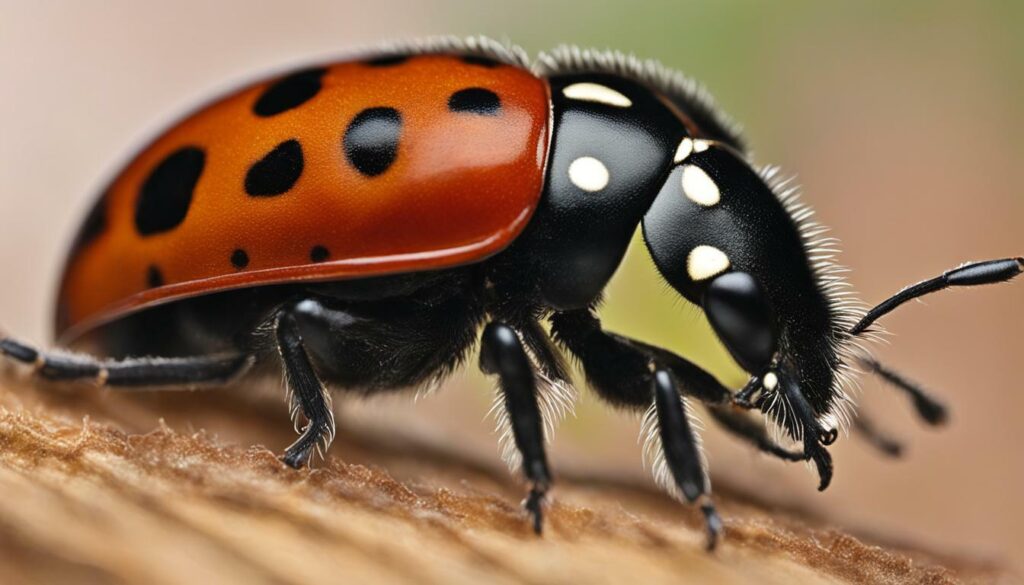
“Ladybug larvae are nature’s tiny assassins, stealthily taking down soft-bodied pests in their path.”
– Entomology Expert
Managing Brown Ladybug Infestations
Dealing with brown ladybug infestations requires a combination of preventive measures and effective removal techniques. In this section, I will provide guidance on how to manage these infestations successfully.
Prevention is key when it comes to brown ladybugs. Start by sealing cracks around windows, doors, and other entry points to prevent them from entering your home. Inspect your home regularly and make sure there are no openings that these insects can use as access points. If you notice an indoor infestation, it is important to act quickly to minimize their presence.
Natural enemies can also help control brown ladybug populations. Encouraging the presence of beneficial insects such as lacewings and hoverflies in your garden can help keep these pests in check. These natural predators feed on ladybug eggs and larvae, reducing their numbers.
If preventive measures are not enough, you may need to resort to insecticides to manage a brown ladybug infestation. However, it is important to exercise caution when using these chemicals. Follow the instructions on the label and use them sparingly. Consider contacting a professional pest control service to ensure safe and effective treatment.
| Prevention Tips | Removal Techniques |
|---|---|
|
|
Remember, brown ladybugs are beneficial insects, so it’s important to handle infestations responsibly. Balancing their presence in your environment is key to maintaining a healthy ecosystem.
Summary
Dealing with brown ladybug infestations requires a proactive approach. Seal cracks and entry points to prevent their entry, while also encouraging natural predators to keep their populations in check. If necessary, use insecticides cautiously and consider professional assistance for severe infestations. By implementing these strategies, you can successfully manage brown ladybug infestations and maintain a harmonious living environment.
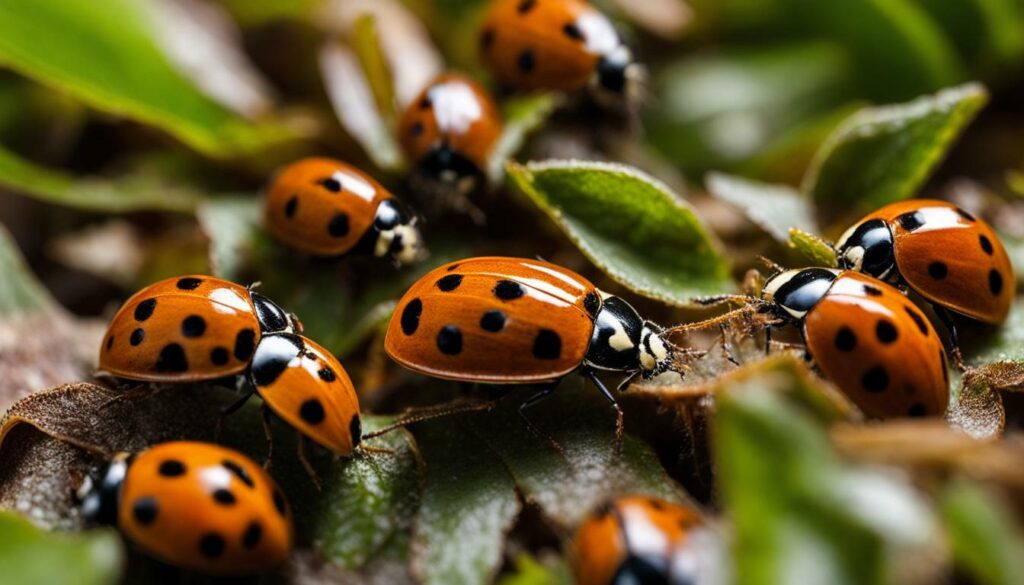
Brown ladybugs often carry misconceptions, and it’s important to separate fact from fiction. In this section, we will debunk common myths and clarify any misunderstandings about these insects. One of the most prevalent misconceptions is that brown ladybugs are harmful. However, the truth is that these insects are harmless and pose no direct threat to humans. Their coloration may resemble that of other harmful species, leading to confusion. It’s important to remember that brown ladybugs are beneficial insects that play a crucial role in controlling aphid populations, acting as natural pest control.
Another misconception is that brown ladybugs are foul-smelling. While it is true that some species of ladybugs, such as the brown marmorated stink bug, emit a pungent odor as a defense mechanism, brown ladybugs themselves do not possess this characteristic. They are not foul-smelling insects and do not release any unpleasant odors. It’s important not to confuse brown ladybugs with other species that are known for their foul smell.
Additionally, there is a misconception that brown ladybugs leave stains on surfaces. This is not entirely true. While ladybugs, including brown ones, may release a yellowish fluid when they feel threatened, it is not a stain-causing substance. The fluid is a defensive secretion that serves to deter potential predators. However, it can be easily wiped away with a gentle surface cleaning method, leaving no lasting stain. It’s important to note that the fluid does not pose any harm to humans or pets.
Brown ladybugs are harmless insects that play a beneficial role in our ecosystems by controlling aphid populations. They are not foul-smelling and do not leave permanent stains on surfaces. It’s essential to debunk these common misconceptions and appreciate the value these insects bring to our natural environment.
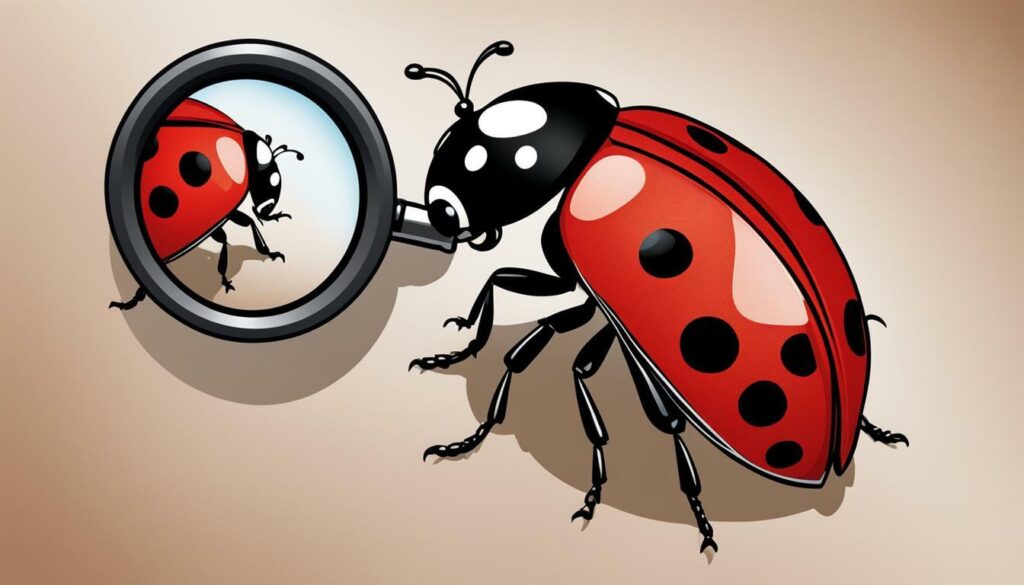
| Myth | Fact |
|---|---|
| Brown ladybugs are harmful. | Brown ladybugs are harmless and beneficial insects. |
| Brown ladybugs are foul-smelling. | Brown ladybugs do not emit any foul odors. |
| Brown ladybugs leave permanent stains. | Brown ladybugs do not leave lasting stains on surfaces. |
Brown Ladybugs in Different Seasons
Brown ladybugs exhibit distinct behaviors and appearances depending on the season. In this section, we will explore how their behavior and feeding habits change during late summer and springtime.
During late summer, brown ladybugs are often seen in abundance as they prepare for the upcoming winter. They may gather in large clusters, seeking shelter in cracks around homes, siding, and entry points such as windows and doors. This behavior is known as overwintering, and it helps them survive the colder months by staying in protected areas.
In terms of feeding habits, brown ladybugs in late summer continue to rely on their preferred food source: soft-bodied pests such as aphids. As they feed on these pests, they provide a natural form of pest control, benefiting gardens and crops that may be infested.
As springtime arrives, the behavior of brown ladybugs undergoes a noticeable change. They become more active, dispersing from their overwintering sites and venturing out to find new food sources. This is also the season when brown ladybug larvae appear, adding to the population. The larvae are bright orange and often mistaken for other soft-bodied pests. These larvae are voracious predators, particularly targeting scale insects. They play an important role in keeping these pests in check.

Summary:
- Brown ladybugs exhibit distinct behaviors and appearances depending on the season.
- In late summer, they gather in clusters around homes and overwinter in cracks and protected areas.
- During late summer, they continue to feed on soft-bodied pests such as aphids, providing natural pest control.
- In springtime, brown ladybugs become more active, dispersing from overwintering sites and searching for new food sources.
- Springtime is also when brown ladybug larvae appear, bright orange and predacious, targeting scale insects.
In the next section, we will explore the benefits and drawbacks of brown ladybugs, shedding light on their role as beneficial insects and potential nuisances they can pose when they gather in large numbers.
Stain Prevention and Removal from Brown Ladybugs
Brown ladybugs, like their red counterparts, can leave stains on various surfaces. In this section, we will share effective techniques for stain prevention and removal, considering their fur-like appearance and the potential presence of mites.
To prevent stains caused by brown ladybugs, it is important to be proactive. Regular surface cleaning can help remove any debris or residue that may attract and hold onto these insects. Using gentle methods like wiping surfaces with a damp cloth or using a mild detergent solution can help prevent staining without causing damage to the material.
When it comes to removing stains left by brown ladybugs, it is crucial to be cautious due to their delicate nature. Harsh cleaning agents should be avoided as they can damage their soft bodies. Instead, try using gentle techniques such as blotting the stain with a mixture of water and mild soap or using a specialized stain remover suitable for the specific surface.
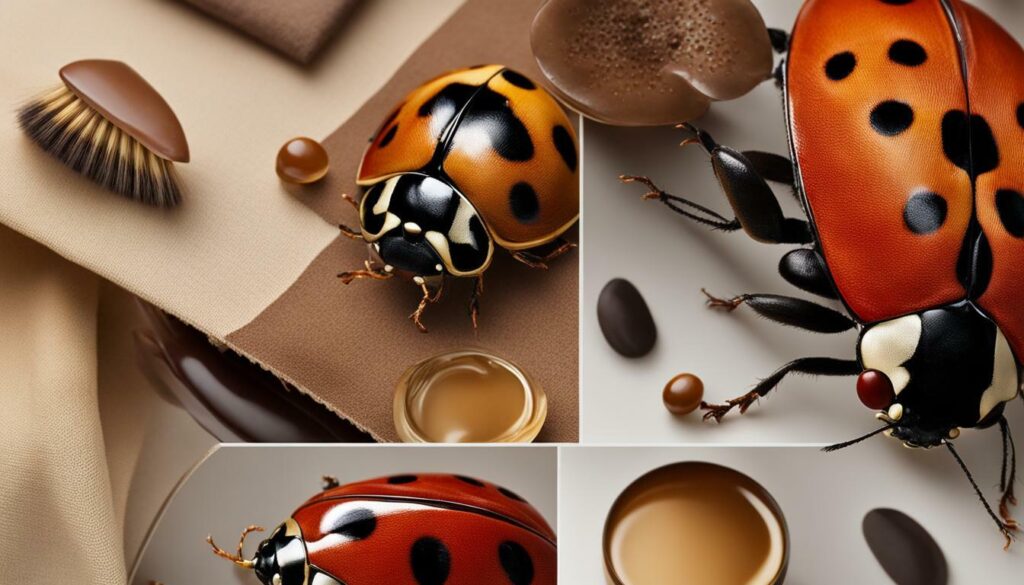
Table: Gentle Stain Removal Techniques
| Surface | Gentle Stain Removal Technique |
|---|---|
| Fabric | Blot the stain with water and mild soap. Rinse thoroughly and wash as usual. |
| Wood | Gently wipe the stain with a damp cloth. If necessary, use a wood cleaner suitable for the specific finish. |
| Glass | Mix equal parts vinegar and water. Dampen a cloth with the solution and gently wipe the stain. |
| Plastic | Create a paste with baking soda and water. Apply the paste to the stain, let it sit for a few minutes, and gently scrub with a soft cloth. |
“Prevention is always better than cure when it comes to handling stains caused by brown ladybugs. Regular cleaning and prompt removal can help preserve the appearance of your surfaces while keeping these insects at bay.”
It is also important to note that brown ladybugs may carry mites. If you suspect the presence of mites, it is recommended to consult a professional exterminator for proper identification and treatment. Taking proactive measures to prevent infestations and promptly addressing any stains caused by brown ladybugs can help maintain a clean and stain-free environment in your home.
Differences Between Brown Ladybugs and Stink Bugs
Brown ladybugs and stink bugs may share some similarities in appearance, but they are different insects. In this section, we will explore the distinctive features of the brown marmorated stink bug and how it differs from brown ladybugs.
The brown marmorated stink bug, scientifically known as Halyomorpha halys, is a larger insect compared to brown ladybugs. It has a distinct black body with white banding on its antennae and legs. This stink bug gets its name from the foul-smelling odor it releases when threatened or disturbed, while ladybugs do not emit any odor. Another notable difference is that stink bugs have a shield-shaped body, whereas ladybugs have a more rounded shape.
“Brown ladybugs and stink bugs may share some similarities in appearance, but they are different insects.”
Moreover, brown marmorated stink bugs are considered a nuisance pest, as they can infest homes in large numbers and seek shelter during colder months. They are typically attracted to the warmth and protection of buildings. On the other hand, ladybugs are beneficial insects that help control aphid populations and are valued for their natural pest control abilities.
| Features | Brown Ladybugs | Brown Marmorated Stink Bugs |
|---|---|---|
| Body Shape | Rounded | Shield-shaped |
| Coloration | Variations of brown with black spots | Black body with white banding on antennae and legs |
| Odor | No odor | Produces foul-smelling odor when threatened |
| Behavior | Beneficial insects, feed on aphids | Nuisance pests, seek shelter in buildings |
Understanding the differences between brown ladybugs and stink bugs is important, as it allows for proper identification and management of these insects. While ladybugs are generally welcomed in gardens for their pest control abilities, stink bugs can be a nuisance due to their odor and potential damage to crops.
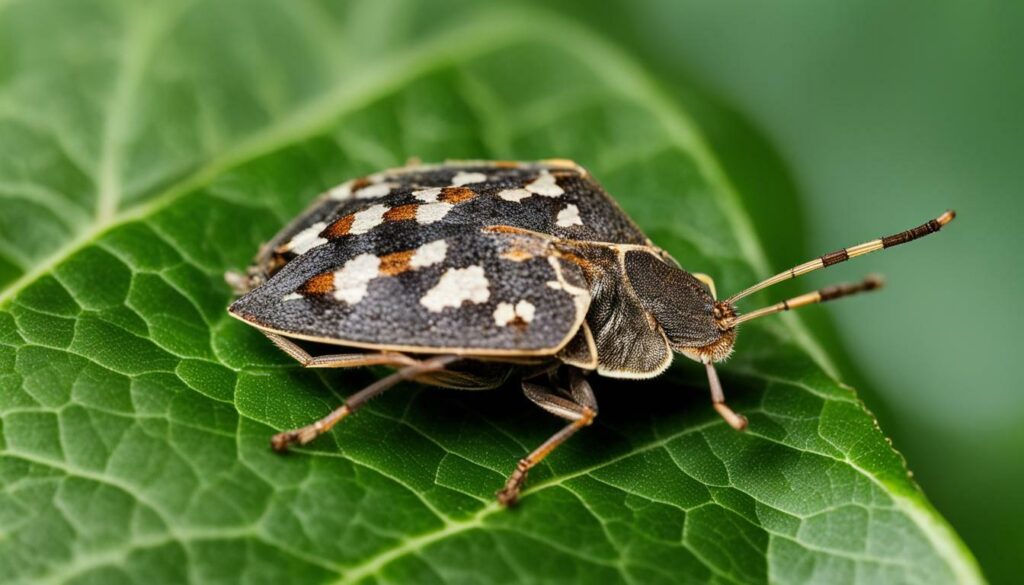
Best Practices for Dealing with Brown Ladybugs
When it comes to managing brown ladybugs, it’s essential to follow best practices to minimize their impact. In this section, we will share practical tips for prevention, removal, and addressing potential nesting areas.
Prevention:
- Seal entry points: Use caulk or weather stripping to seal cracks and gaps around windows, doors, and other potential entry points where ladybugs can infiltrate your home.
- Remove outdoor attractants: Keep outdoor lights off at night as they can attract ladybugs. Additionally, consider removing or reducing the presence of plants and trees near your home that ladybugs may use as shelter.
Removal:
- Vacuum cleaner: Use a vacuum cleaner with a hose attachment to gently remove ladybugs from surfaces. Empty the vacuum bag or canister outdoors to prevent them from re-entering your home.
- Squish with caution: If you prefer not to use a vacuum cleaner, you can gently squish ladybugs with a tissue or cloth. However, be aware that squishing ladybugs can release a yellowish liquid that may stain surfaces.
Addressing Nesting Areas:
- Inspect and clean: Regularly inspect and clean areas where ladybugs may nest, such as attics, crawlspaces, and basement windows. Remove any debris or organic matter that could attract them.
- Consider outdoor sprays: Apply insecticides labeled for outdoor use around the perimeter of your home to deter ladybugs from gathering on the side of the house. Follow the instructions carefully and use caution to prevent harm to beneficial insects and the environment.
By following these best practices, you can effectively manage brown ladybugs and minimize any potential nuisances they may cause. Remember that these insects play an important ecological role, so it’s best to handle them with care and respect.
Table: Common Best Practices for Dealing with Brown Ladybugs
| Best Practices | Description |
|---|---|
| Seal entry points | Use caulk or weather stripping to seal cracks and gaps around windows, doors, and other potential entry points where ladybugs can infiltrate your home. |
| Remove outdoor attractants | Keep outdoor lights off at night as they can attract ladybugs. Additionally, consider removing or reducing the presence of plants and trees near your home that ladybugs may use as shelter. |
| Vacuum cleaner | Use a vacuum cleaner with a hose attachment to gently remove ladybugs from surfaces. Empty the vacuum bag or canister outdoors to prevent them from re-entering your home. |
| Squish with caution | If you prefer not to use a vacuum cleaner, you can gently squish ladybugs with a tissue or cloth. However, be aware that squishing ladybugs can release a yellowish liquid that may stain surfaces. |
| Inspect and clean | Regularly inspect and clean areas where ladybugs may nest, such as attics, crawlspaces, and basement windows. Remove any debris or organic matter that could attract them. |
| Consider outdoor sprays | Apply insecticides labeled for outdoor use around the perimeter of your home to deter ladybugs from gathering on the side of the house. Follow the instructions carefully and use caution to prevent harm to beneficial insects and the environment. |

Following these best practices will help you effectively manage brown ladybugs, ensuring a harmonious living environment for both you and these fascinating insects.
Conclusion: Appreciating the World of Brown Ladybugs
Brown ladybugs may be lesser-known compared to their red counterparts, but they deserve our attention and appreciation. In this concluding section, we will reflect on the ecological significance and uniqueness of brown ladybugs.
These diverse species of brown ladybugs, such as the Asian lady beetle, kudzu bug, larch ladybug, and painted ladybug, play an important role in our ecosystems. Their brown coloration serves as a defense mechanism, allowing them to blend in with their surroundings and avoid predators.
While they may sometimes be a nuisance when they gather in large numbers around our homes, we must remember that brown ladybugs are beneficial insects. They help control aphid populations, which can be harmful to plants. By preying on these soft-bodied pests, brown ladybugs contribute to the overall health of our gardens and crops.
Furthermore, the uniqueness of these brown ladybugs adds to the beauty of the natural world. Their coloration and patterns vary across species, with some featuring dark brown tones, mottled markings, or even bright orange accents. By appreciating the diversity within the beetle family Coccinellidae, we gain a deeper understanding of the intricate web of life that surrounds us.
FAQ
What is the bug that looks like a ladybug but is brown?
The bug that resembles a ladybug but is brown is most likely the Asian lady beetle or Japanese ladybug (Harmonia axyridis). It is orange-brown in color and can be a nuisance, especially in the fall and winter when it gathers in large numbers around houses.
Are brown ladybugs beneficial insects?
Yes, brown ladybugs, such as the Asian lady beetle, are beneficial insects. They eat aphids and help control their populations. However, they can become a problem when they enter homes in large numbers.
How can I remove brown ladybugs from my home?
Brown ladybugs can be removed from your home using a vacuum cleaner. You can also use outdoor sprays to discourage them from gathering on the side of the house.
What is the kudzu bug?
The kudzu bug is another brown bug that is often mistaken for a ladybug. It is about a quarter of an inch long, dark brown or olive in appearance, and feeds on kudzu, soybeans, and ornamental plants.
Can brown ladybugs stain surfaces?
Yes, brown ladybugs, especially if crushed, can stain surfaces. It is recommended to avoid squishing them, as it may result in staining.
Are there different types of brown ladybugs?
Yes, there are different types of brown ladybugs, such as the larch ladybug and the painted ladybug. These ladybugs have different features and habitats but are all part of the beetle family Coccinellidae.

